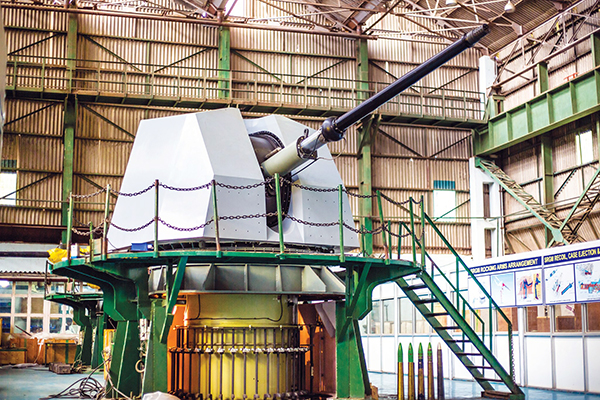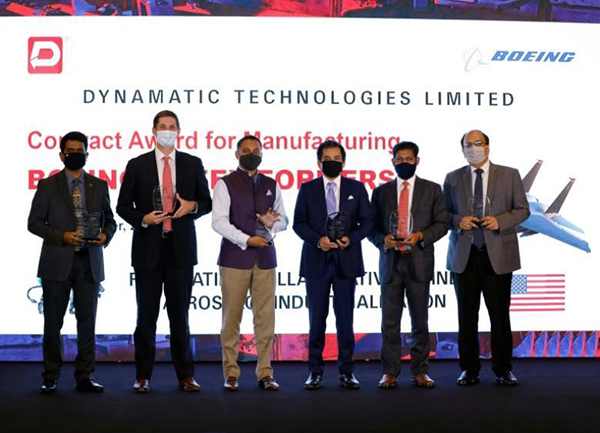BHEL To Supply Upgraded Main Guns For Navy Frigates
In a major boost to Defence Production under the ‘Make in India’ initiative and towards achieving self-reliance in the critical field of Defence equipment, Goa Shipyard has placed a maiden order on Bharat Heavy Electricals Limited (BHEL) for supply of an upgraded Super Rapid Gun Mount (SRGM), the Main gun onboard most Warships of the Indian Navy.
The order envisages supply, installation and commissioning of the entire system – Upgraded SRGM and accessories for Triput Class Frigates of the Indian Navy, which will be manufactured by the Haridwar unit of BHEL.
The upgraded SRGM is a state-of-the-art weapon system having additional features such as capability to manage different types of ammunition to engage fast, manoeuvring and non-manoeuvring, radio controlled targets. The upgraded SRGM has the capability to fire advanced Ammunition with higher range and programmable ammunition.
BHEL has been a reliable supplier of critical equipment and services in the Defence and Aerospace sector for over three decades with the aim of making a major contribution towards self-reliance in these sectors.
Towards this, BHEL has established dedicated, intricate manufacturing and inspection facilities at its manufacturing plants, for production, installation & commissioning and lifecycle support of various products and components. The initiatives taken by BHEL will be a driving force towards the AatmaNirbhar Bharat Abhiyan of the Government of India.
LCA-Mk2 to Roll Out Next Year
The configuration for the Light Combat Aircraft (LCA)-Mk2 has been frozen and steel cutting is expected to begin soon while configuration for the fifth-generation Advanced Medium Combat Aircraft (AMCA) has been frozen and preliminary design completed, Dr Girish S. Deodhare, Programme Director (Combat Aircraft) & Director, ADA, said at a seminar in New Delhi on 12 September.
“The detailed design is complete. In fact, we are in the critical design review stage and metal cutting should start very shortly. Roll-out of the aircraft (Mk2) is planned next year and the first flight in early 2023. We are well on track to achieve these goals,” Dr Deodhare said.
The aircraft features enhanced range and endurance including an onboard oxygen generation system, which is being integrated for the first time, Dr. Deodhare said.
Heavy weapons of the class of Scalp, Crystal Maze and Spice-2000 will also be integrated on the Mk2. The LCA-Mk2 will be a heavier and much more capable aircraft than the current LCA variants.
The Mk2 is 1,350 mm longer featuring canards and can carry a payload of 6,500 kg compared to 3,500 kg the LCA can carry.
In February, the Defence Ministry signed a Rs 48,000-crore deal with Hindustan Aeronautics Ltd. (HAL) to supply 83 LCA-Mk1A to the Indian Air Force. In August, the HAL signed a $716 million deal with GE Aviation of the U.S. for 99 F404 aircraft engines and support services to power the Mk-1A. The Mk2 will be powered by a more powerful GE-414 engine.
The Indian Air Force (IAF) has one squadron of the LCA in initial operational clearance and deliveries of the second squadron in final operational clearance configuration are under way.
The HAL has already set up a second assembly line to ramp up production from eight aircraft a year to 16. Order for 83 Mk-1A is expected to be completed by 2028-29, Dr. Deodhare said.
Preliminary Design Review of AMCA Completed
According to Dr Girish S. Deodhare, Programme Director (Combat Aircraft) & Director, ADA, the the configuration of the Advanced Medium Combat Aircraft (AMCA) had been frozen, preliminary service quality requirements finalised and preliminary design review completed. The initial design of the AMCA was started way back in 2009.
“We are moving to critical design review by the middle of next year with the roll-out planned in 2024 and first flight planned in 2025,” he said at a seminar on 12 September, in New Delhi.
The AMCA would be a twin engine stealth aircraft with an internal weapons bay and a diverterless supersonic intake, which has been developed for the first time for which the design is complete.
It will be a 25-tonne aircraft with internal carriage of 1,500 kg of payload and 5,500-kg external payload with 6,500 kg of internal fuel.
The AMCA will have stealth and non-stealth configuration and will be developed in two phases, AMCA Mk1 with existing GE414 engine and an AMCA Mk2 with an advanced, more powerful engine to be developed later along with a foreign partner, Dr. Deodhare added.
The manufacturing and production of the aircraft will be through a special purpose vehicle, which will also have participation of private industry.
Simultaneously, the project for development of a twin-engine deck-based fighter jet meant to fly from the Navy’s aircraft carriers is also making progress. On the various programmes under way, Dr. Deodhare said there was commonality of systems and technologies.
Aerostructures of Boeing’s F-15EX Eagle II to be Built in India
Aerospace major Boeing has awarded a contract to India-based Dynamatic Technologies for manufacturing assemblies for its tactical fighter ‘F-15EX Eagle II’. This is a first instance in which aerostructures for F-15EX Eagle II will be made in India. Besides, the contract will given a boost to the ‘Aatmanirbhar’ programme and strengthens US-India collaboration on aerospace and defence industrialisation.
Accordingly, Dynamatic Technologies will supply the F-15EX aerostructure assembly requirements from FY22. The company will manufacture these aerostructures from their manufacturing facility in Bengaluru, Karnataka.
According to Boeing India President Salil Gupte: “We see tremendous potential for India to contribute to the global aerospace industry as an industrial and technology partner.”
“The award of aerostructure assemblies for the latest and most advanced version of the F-15 aircraft family is a reflection of Boeing’s focus on Aatmanirbhar Bharat and a testimony to the world class capability of our industrial partners in India.”
Army Taps Tonbo Imaging for Specialised Sights
The Army has placed orders with with a Bengaluru-based firm – Tonbo Imaging – for specialised sights under emergency procurement to help some of its elite units operating in both urban warfare and at the borders. The order for two set of sights as part of a spate of emergency procurement being done was placed “recently”.
One contract is for about 600 pieces of multi-functional thermal imaging binoculars for target acquisition and the other is for multi mission-sight, which can be mounted on the helmet and also the weapon.
The contract value is for over Rs 100 crore and the procurement is being done by the Infantry Directorate, adding that while earlier the Northern Command had procured one of these sights for its soldiers in smaller batches, this time the Army Headquarters is doing it.
They also said that there would be a larger procurement order in play if the systems, which have to be delivered in 12 months, perform according to expectations.
The multi-mission sights are lighter and more tuned for close combat.
Tonbo Imaging is one of the few companies in the world to manufacture such systems. Some of their products are deployed at the Line of Actual Control (LAC) during the ongoing Ladakh standoff for surveillance operations.
When the company initially began commercial operations around 2012, it focused on the global market. Five countries were buying their products before India bought from Tonbo. Founder Arvind Lakshmikumar’s prior work with US’ DARPA (Defense Advanced Research Projects Agency) helped him get recognition of products early on in the US market.
Rolls-Royce, HAL Pact for Adour Engine Parts
Rolls-Royce and Hindustan Aeronautics Limited (HAL) signed a “Make in India” agreement, on 14 September, to manufacture parts for Rolls-Royce’s Adour engines that will support the UK-headquartered company’s international defence customer base.
Variants of the Adour engine power the Indian Air Force’s (IAF) Jaguar fighters as well as its fleet of Hawk advanced jet trainers (AJT). The IAF has the world’s largest serving fleets of both these aircraft. HAL has manufactured and supported Adour engine variants, under licence from Rolls-Royce, over several decades.
However, Rolls-Royce now aims to strengthen the spares and maintenance ecosystem for Adour engines in India. Rolls-Royce and HAL signed a Memorandum of Understanding (MoU) during Aero India 2021, in February, to establish an Authorised Maintenance Centre for Adour at HAL to support international military customers and operators.
Rolls-Royce underscores a three-point aim in the current initiative. The first is to equip Indian manufacturers with the knowhow, processes and experience to build complex parts that require a lot of high-technology processes. That would enhance current capabilities and serve to make India atmanirbhar (self-reliant). Secondly, exporting parts from India would enhance supply chain efficiency and benefit Rolls-Royce’s global operators. Thirdly, since the Adour engines will continue to fly in India for the longest time, a self-sufficient supply chain would be in place to support those older engines.
Thales to Provide Emerging Technologies for Armed Forces
Leading French defence major Thales Group is planning to focus significantly on addressing requirements of the Indian armed forces for new-age cyber security solutions, artificial intelligence and advanced capabilities in big data analytics.
Chairman and CEO of Thales Group Patrice Caine said the company has been looking at expanding its overall footprint in India, particularly in the areas of emerging technologies that will be crucial for the armed forces.
The Indian Army, the Navy and the Indian Air Force have been focusing on acquiring futuristic technologies like nanotechnology, quantum computing, artificial intelligence, swarm drones and robotic technologies to deal with future security challenges.
Thales Group is aiming at expanding its overall footprint in India in a number of segments, including in areas of cyber security, artificial intelligence and digital solutions.
India is expected to spend close to $300 billion in the next five years in procuring defence equipment and almost all major global defence firms are eyeing a slice of it.
India is now considered as a key country for sourcing various raw materials for the company’s global production line and it is going to double procurement from the country in the next five years.
Thales is part of the French firms that provided key components for the Rafale jets procured by India. As part of Thales’ offsets commitments under the Rafale deal, the company helped Bharat Electronics Ltd (BEL) in producing modules for the RBE2 radar.
Thales has been providing avionics and other equipment to the state-run aerospace behemoth Hindustan Aeronautics Limited for over four decades and is involved in supplying equipment for various other key military projects.
Present in India since 1953, Thales has offices in New Delhi, Gurgaon, Hyderabad, Bengaluru, Chennai and Mumbai, among others. Over 600 employees are working with Thales and its joint ventures in India.






















